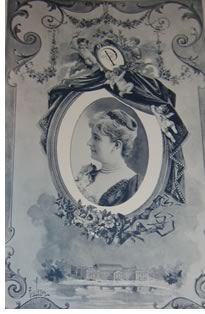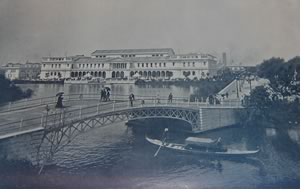

Architects Louise B. Bethune and Sophia G. Hayden, and the likes of Mrs. Potter Palmer
by Tony Wrenn, Hon.
AIA
At the 1892-93 World’s Columbian Exposition in Chicago,
something that had not been done before at any world’s fair
was planned. There would be a building devoted solely to women. All
buildings were to be designed by architects, and Daniel Burnham,
the exposition’s chief of construction, sought the best known
American architects as designers. He would have known Louise
Bethune, FAIA, a woman architect, and member of the AIA. She was
clearly capable of designing the Woman’s Building—she
had, after all, designed schools, a hotel, a police station, a
baseball field, and other buildings in Buffalo, where her
architecture office was located—but was not nationally known.
Burnham may have had her in mind, may even have offered her the
job. If so, she refused and he ordered a competition among American
women architects for the design of the building. (Larson, Eric,
Devil in the White City, p.
120.)
 Bethune,
who was the first woman elected to the AIA in 1888, addressed the
Women’s Educational and Industrial Union of Buffalo, on May 6,
1891, after the competition was announced. “Chairman and
Ladies of the Educational Committee,” she began, “you
have requested me to speak upon ‘Women in Architecture.’
The subject might, from a masculine standpoint, at least, be
disposed of with the brevity which characterized the famous chapter
upon the ‘Snakes of Ireland.’” She spoke of
Egyptians, English queens, and of the “sainted women of
Catholic Europe who built and governed monasteries as well as
nunneries, and who founded and endowed charities and schools.”
She recounted advances being made in the U.S., where schools of
architecture had recently been established, which women were
entering, and from which they were graduating.
Bethune,
who was the first woman elected to the AIA in 1888, addressed the
Women’s Educational and Industrial Union of Buffalo, on May 6,
1891, after the competition was announced. “Chairman and
Ladies of the Educational Committee,” she began, “you
have requested me to speak upon ‘Women in Architecture.’
The subject might, from a masculine standpoint, at least, be
disposed of with the brevity which characterized the famous chapter
upon the ‘Snakes of Ireland.’” She spoke of
Egyptians, English queens, and of the “sainted women of
Catholic Europe who built and governed monasteries as well as
nunneries, and who founded and endowed charities and schools.”
She recounted advances being made in the U.S., where schools of
architecture had recently been established, which women were
entering, and from which they were graduating.
Bethune discussed architecture, “never satisfactorily defined
. . . It is not construction in any of its various branches nor is
it arrangement of interior nor exterior, nor coloring, nor carving,
nor profiling of moldings; neither is it acoustics, nor
fenestration, nor sanitation, nor any one of a hundred other
things. It is the arranging and adjuncting, harmonizing and
contrasting of all these and many other elements into a suitable
and satisfactory whole.” Women, she said, had entered the
architecture profession earlier than women had entered other
professions, “even before it has received legislative
recognition,” which did not come until 1897 when Illinois was
the first state to adopt an architectural licensing law.
Bethune said women architects “meet no serious opposition from
the profession nor the public. Neither are they warmly welcomed.
They minister to no special needs of women, and receive no special
favors from them.” She concluded that one threshold remained
to be crossed by women, that of “Equal Remuneration for Equal
Service.” Whether Bethune invented the phrase is not known,
but the fact that she used it in 1891 indicates the depth of her
thought and concern for the profession.
Unequal pay for equal work
The Inland Architect and
News Record, which reported Bethune’s speech, notes
that she was asked about the Woman’s Building suggested for
the World’s Columbian Exposition in Chicago. (The Inland Architect and News
Record, Vol XVII, No. 2, March 1891, pages 20-21) She
responded that “the idea of separate Women’s Board
Exhibit, etc., expresses a sense of inferiority which business
women are far from feeling.” She pointed out the evils of
architectural competition (also opposed at the time by the AIA),
which was to be used to select a woman architect for the
building.
Worst of all, the competition winner would be paid $1,000,
“about three-tenths [actually it was only one tenth, for male
architects were paid $10,000] of the average rate paid the already
appointed architects [all male] for nearly similar service,”
which was, she noted “an unfortunate precedent to establish
just now, and it may take years to live down its effects.” In
point of fact, 110 years later, equal pay for equal work has not
yet become widespread.
 Still, the
competition for the Women’s Building at the Columbian
Exposition was held, and architect Sophia G. Hayden’s design
was selected. Chief-of-construction Burnham reported that
“Miss Hayden was at once employed as the architect of the
building, and it has been constructed upon her designs and under
her supervision. ‘Examination of the facts,’ testified
Mr. Burnham emphatically, ‘shows that this woman had no help
whatever in working up the designs. It was done by herself in her
own home.’” (Hon. William E. Cameron, editor, History of the World’s Columbian
Exposition, Chicago, Columbian History Company, 1893, page
42.)
Still, the
competition for the Women’s Building at the Columbian
Exposition was held, and architect Sophia G. Hayden’s design
was selected. Chief-of-construction Burnham reported that
“Miss Hayden was at once employed as the architect of the
building, and it has been constructed upon her designs and under
her supervision. ‘Examination of the facts,’ testified
Mr. Burnham emphatically, ‘shows that this woman had no help
whatever in working up the designs. It was done by herself in her
own home.’” (Hon. William E. Cameron, editor, History of the World’s Columbian
Exposition, Chicago, Columbian History Company, 1893, page
42.)
Mrs. Palmer Potter
strikes
The report of the Board of Lady Managers, headed by Mrs. Potter
Palmer, disposes of Hayden somewhat differently. The Woman’s
Building, she reported, was “designed by Miss Sophia G.
Hayden, a Boston architect, only 22 years old, and a modest girl of
such retiring appearance that architecture is the last thing one
would think her guilty of . . . It was not generally known in this
country that there were many women architects until the design for
the building was called for. The President of the Board [Palmer]
admitted that it was with dread of the results of the competition
that she attended the meeting of architects who adjudicated the
plans submitted for female competitors.
“There were fourteen in all,” she continues, “and to
the astonishment of the judges, who were in the blessed frame of
mind which expects little, the designs were all possessed of more
than ordinary claims to recognition. Several were extremely fine,
some of excellent originality, and none entirely bad . . . With two
exceptions the contestants came from the Southern and Western
states. Miss Hayden is of Spanish extraction, and a native of South
America, but having been reared and educated in Boston, and a
graduate of its school of Technology [she was the first woman to
graduate in architecture from MIT], is essentially an American
girl.”
“But of the Woman’s Building . . . The Board of Lady
Managers wields entire control and management.” (History, p. 160)
Perhaps Hayden should have heeded the AIA’s warning about the
evils of competitions. Perhaps she should have talked to Bethune.
Perhaps Burnham should have used his influence to persuade Bethune
to undertake the building design. He had after all been influential
enough to persuade Richard Morris Hunt, perhaps then the
nation’s leading architect, and a reluctant designer for the
World’s Columbian Exposition, to design for the fair.
A Gilded Age battle
Hayden did enter, and her design was chosen. She accepted the
$1,000, completed drawings for the building, and came to Chicago to
supervise the completion of the building exterior. Mrs. Palmer
apparently had other ideas, and she and Hayden were at odds. The
22-year-old counteracted the decisions of the grand dame, intent on
ensuring that the building she had designed was carried to
completion in accordance with her designs. She seems, however, to
have had neither the wiles nor the maturity to win, and the
conflict ended in tragedy for her.
It was “a battle . . . fought in true Gilded Age fashion, with
oblique snubs and poisonous courtesy. Mrs. Palmer pecked and
pestered and catapulted icy smiles into Hayden’s deepening
gloom. Finally Palmer assigned the decoration of the Woman’s
Building to someone else . . .
“Hayden fought the arrangement in her quiet, stubborn way
until she could take it no longer. She walked into Burnham’s
office, began to tell him her story, and promptly, literally, went
mad: tears, heaving sobs, cries of anguish, all of it. ‘A
severe breakdown,’ an acquaintance called it, ‘with a
violent attack of high nervous excitement of the brain.’
“Burnham, stunned, summoned one of the exposition surgeons.
Hayden was discretely driven from the park in one of the
fair’s innovative English ambulances with quiet, rubber tires
and placed in a sanitarium for a period of enforced rest. She
lapsed into ‘melancholia,’ a sweet name for
depression.”
 The
Women’s Building, under Burnham’s direction, one of the
first of the exposition buildings completed, was a success. Today,
in remembering that Hayden had a nervous breakdown trying to ensure
completion of the building after her design, it is well to remember
the patronizing Mrs. Potter Palmer, the wife of the man who owned
Chicago’s best known hotel, secure in her position as a leader
of Chicago society, and in her belief that architecture was
“the last thing one would think her [Sophia Hayden, and by
extension, any woman] guilty of.” (History, p. 160)
The
Women’s Building, under Burnham’s direction, one of the
first of the exposition buildings completed, was a success. Today,
in remembering that Hayden had a nervous breakdown trying to ensure
completion of the building after her design, it is well to remember
the patronizing Mrs. Potter Palmer, the wife of the man who owned
Chicago’s best known hotel, secure in her position as a leader
of Chicago society, and in her belief that architecture was
“the last thing one would think her [Sophia Hayden, and by
extension, any woman] guilty of.” (History, p. 160)
An unfair legacy
Minerva Parker Nichols, a Philadelphian who had entered the
competition for the Women’s Building, and lost to Hayden,
understood what happened in 1893 in Chicago, and its effect on
women then practicing architecture. “It is not fair,” she
noted, “because one woman makes a doubtful success, to draw
conclusions from her example . . . Because one woman suffers from
exhaustion in the daily wear and tear of her household duty, you
would not say that women were unfitted for domestic life.”
(Ellen Perry Berkeley and Matilda McQuaid, Architecture A Place for
Women, Washington: Smithsonian Institution
Press, 1989, p. 32.)
Still today, when Hayden’s name comes up, one will hear not of
the 22-year-old who designed one of the most popular buildings in
the great White City, but of the woman architect who had a nervous
breakdown while supervising, against great odds, its
construction.
Copyright 2005 The American Institute of Architects. All rights reserved. Home Page

